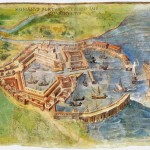 Researchers from the University of Southampton have been excavating the ancient man-made harbour of Portus in modern day Fiumicino, 20 miles southwest of Rome, since 1998. In collaboration with experts from the British School at Rome, the University of Cambridge, and the Soprintendenza Speciale per i Beni Archeologici di Roma, they have explored the warehouses of Septimius Severus, the imperial palace, cisterns, an amphitheater, a massive shipyard, a bath complex and more.
Researchers from the University of Southampton have been excavating the ancient man-made harbour of Portus in modern day Fiumicino, 20 miles southwest of Rome, since 1998. In collaboration with experts from the British School at Rome, the University of Cambridge, and the Soprintendenza Speciale per i Beni Archeologici di Roma, they have explored the warehouses of Septimius Severus, the imperial palace, cisterns, an amphitheater, a massive shipyard, a bath complex and more.
The Portus Project website describes the immense historical significance of this site.
Portus (Fiumicino) was the maritime port of ancient Rome and, together with the neighbouring river port at Ostia, was the focus of a network of ports serving Imperial Rome between the mid-1st century AD and the 6th century AD. It was established by Claudius in the mid-1st century AD, enlarged by Trajan, and subsequently modified during the 3rd and 4th centuries AD. The port began to enter a period of slow decline from the late 5th century AD onwards, although it was the scene of a major struggle between Byzantine and Ostrogothic troops during the Gothic wars (AD 535-553).
Portus was critically important for supplying the city of Imperial Rome with foodstuffs and materials from across the Mediterranean from the 1st century AD onwards. It also acted as both a point of export for supplies and products from the Tiber Valley to the north of Rome, and a major hub for the redistribution of goods from ports across the Mediterranean. It must also have acted as a major conduit for people visiting Rome from around the Mediterranean.
Now the University of Southampton is giving all us little nerd urchins (nurchins?) a chance to do more than press our faces against the glass. It’s offering a Massive Open Online Course (MOOC) on the archaeology of Portus. The course is open to everyone free of charge and will include access to all the Portus Project’s research data so that students can explore the nuts and bolts of Portus and the archaeological process.
On this course you will chart a journey from the Imperial harbour to its connections across the Mediterranean, learning about what the archaeological discoveries uncovered by the Portus Project tell us about the history, landscape, buildings, and the people of this unique place. Although the site lies in ruins, it has some of the best-preserved Roman port buildings in the Mediterranean, and in this course you will learn to interpret these and the finds discovered within them, using primary research data and the virtual tools of the archaeologist.
Largely filmed on location at Portus, the course will provide you with an insight into the wide range of digital technologies employed to record, analyse and present the site. In addition to the lead educators, our enthusiastic team of student archaeologists will support your learning.
To register click here, fill in your name and email address and check the privacy policy and code of conduct boxes. The course starts on May 19th and is divided into six week-long classes. Once it’s open, you can go through the whole program in a weekend, if you want, or you can stretch it out longer than six weeks to suit your schedule. There are discussion modules with technology that allows you to follow particular learners. There’s a handy dandy Twitter hashtag (#UoSFLPortus) to carry on the conversation on social media. There are quizzes, scored tests and what looks like some really awesome homework.
So how about it? Shall we take a Roman archaeology class together? :boogie:
[youtube=http://youtu.be/hnECQ7FdD2w&w=430]
I’m in! Are you doing the Richard III one as well?
I am now! Shall we follow each other? Here’s my profile.
I’m signed up! Also- This is hands down my favorite history blog! 😀
Was going to ask if they let in American riff-raff, but then realized I am likely to be traveling to see family (and do some other research) during that time. But I see the R3 course later on– I’ll be home, going to check that one out, sounds fascinating.
I’ll have to see how busy I am closer to the time. I’m definitely interested (in Richard III as well).
Signing up nao
Jeder liebt, was ejch sind. Diese Art deer Arbneit und kluge exposure!
Halten Sie sich die hervorragende funktioniert Jungs Ich habe eingebaut euch zu
unsere Blogroll.
Ahaa, seine anspruchsvoollen Unteryaltung Impressum Schriftstück hier an diesem Webseite, Ich
habe alle, die so gelesen jerzt mich auch zu kommentieren an dieser
Stelle.